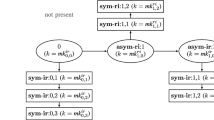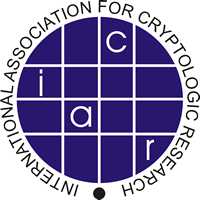Abstract
Signal is a famous secure messaging protocol used by billions of people, by virtue of many secure text messaging applications including Signal itself, WhatsApp, Facebook Messenger, Skype, and Google Allo. At its core it uses the concept of “double ratcheting,” where every message is encrypted and authenticated using a fresh symmetric key; it has many attractive properties, such as forward security, post-compromise security, and “immediate (no-delay) decryption,” which had never been achieved in combination by prior messaging protocols.
While the formal analysis of the Signal protocol, and ratcheting in general, has attracted a lot of recent attention, we argue that none of the existing analyses is fully satisfactory. To address this problem, we give a clean and general definition of secure messaging, which clearly indicates the types of security we expect, including forward security, post-compromise security, and immediate decryption. We are the first to explicitly formalize and model the immediate decryption property, which implies (among other things) that parties seamlessly recover if a given message is permanently lost—a property not achieved by any of the recent “provable alternatives to Signal.”
We build a modular “generalized Signal protocol” from the following components: (a) continuous key agreement (CKA), a clean primitive we introduce and which can be easily and generically built from public-key encryption (not just Diffie-Hellman as is done in the current Signal protocol) and roughly models “public-key ratchets;” (b) forward-secure authenticated encryption with associated data (FS-AEAD), which roughly captures “symmetric-key ratchets;” and (c) a two-input hash function that is a pseudorandom function (resp. generator with input) in its first (resp. second) input, which we term PRF-PRNG. As a result, in addition to instantiating our framework in a way resulting in the existing, widely-used Diffie-Hellman based Signal protocol, we can easily get post-quantum security and not rely on random oracles in the analysis.
J. Alwen—Partially supported by the European Research Council under ERC Consolidator Grant (682815 - TOCNeT).
S. Coretti—Supported by NSF grants 1314568 and 1319051.
Y. Dodis—Partially supported by gifts from VMware Labs, Facebook and Google, and NSF grants 1314568, 1619158, 1815546.
Access this chapter
Tax calculation will be finalised at checkout
Purchases are for personal use only
Similar content being viewed by others
Notes
- 1.
Namely, good randomness is only needed to achieve PCS, while all other security properties hold even with the adversarially controlled randomness (when parties are not compromised).
- 2.
Specifically, the healing time of the generic Signal protocol presented in this work is \(\Delta _{\mathsf {SM}}= 2 + \Delta _{\mathsf {CKA}}\).
- 3.
For syntactic reasons having to do with our abstractions, our protocol is a minor variant of Signal, but is logically equivalent to Signal in every aspect.
- 4.
The reader may skip over this definition on first read. The properties are referenced where they are needed.
- 5.
- 6.
Of course, one could also parametrize the number of rounds required to recover (all CKA schemes in this work recover within two rounds, however).
- 7.
The DDH assumption states that it is hard to distinguish DH triples \((g^a,g^b,g^{ab})\) from random triples \((g^a,g^b,g^c)\), where a, b, and c are uniformly random and independent exponents.
- 8.
For ease of description, the FS-AEAD state of the parties is not made explicit as a variable \(v\).
- 9.
\(\mathsf B\) also starts in epoch \(t_{\mathsf B}\leftarrow 0\).
References
Alkim, E., Ducas, L., Pöppelmann, T., Schwabe, P.: Post-quantum key exchange - a new hope. In: Holz, T., Savage, S., (eds.) 25th USENIX Security Symposium, pp. 327–343. USENIX Association (2016)
Alwen, J., Coretti, S., Dodis, Y.: The double ratchet: security notions, proofs, and modularization for the signal protocol. Cryptology ePrint Archive, Report 2018/1037 (2018). https://eprint.iacr.org/2018/1037
Bellare, M., Singh, A.C., Jaeger, J., Nyayapati, M., Stepanovs, I.: Ratcheted encryption and key exchange: the security of messaging. In: Katz, J., Shacham, H. (eds.) CRYPTO 2017, Part III. LNCS, vol. 10403, pp. 619–650. Springer, Cham (2017). https://doi.org/10.1007/978-3-319-63697-9_21
Bellare, M., Yee, B.: Forward-security in private-key cryptography. In: Joye, M. (ed.) CT-RSA 2003. LNCS, vol. 2612, pp. 1–18. Springer, Heidelberg (2003). https://doi.org/10.1007/3-540-36563-X_1
Borisov, N., Goldberg, I., Brewer, E.A.: Off-the-record communication, or, why not to use PGP. In: Proceedings of the 2004 ACM Workshop on Privacy in the Electronic Society, WPES 2004, 28 October 2004, pp. 77–84 (2004)
Bos, J., et al.: Crystals - kyber: a CCA-secure module-lattice-based KEM. Cryptology ePrint Archive, Report 2017/634 (2017). https://eprint.iacr.org/2017/634
Cohn-Gordon, K., Cremers, C.J.F., Dowling, B., Garratt, L., Stebila, D.: A formal security analysis of the signal messaging protocol. In: 2017 IEEE European Symposium on Security and Privacy, EuroS&P 2017, pp. 451–466. IEEE (2017)
Cohn-Gordon, K., Cremers, C.J.F., Garratt, L.: On post-compromise security. In: IEEE 29th Computer Security Foundations Symposium, CSF 2016, pp. 164–178. IEEE Computer Society (2016)
Derler, D., Jager, T., Slamanig, D., Striecks, C.: Bloom filter encryption and applications to efficient forward-secret 0-RTT key exchange. In: Nielsen, J.B., Rijmen, V. (eds.) EUROCRYPT 2018, Part III. LNCS, vol. 10822, pp. 425–455. Springer, Cham (2018). https://doi.org/10.1007/978-3-319-78372-7_14
Durak, F.B., Vaudenay, S.: Bidirectional asynchronous ratcheted key agreement without key-update primitives. Cryptology ePrint Archive, Report 2018/889 (2018). https://eprint.iacr.org/2018/889
Messenger secret conversations: Technical whitepaper. https://fbnewsroomus.files.wordpress.com/2016/07/secret_conversations_whitepaper-1.pdf
Gentry, C., Silverberg, A.: Hierarchical ID-based cryptography. In: Zheng, Y. (ed.) ASIACRYPT 2002. LNCS, vol. 2501, pp. 548–566. Springer, Heidelberg (2002). https://doi.org/10.1007/3-540-36178-2_34
Green, M.D., Miers, I.: Forward secure asynchronous messaging from puncturable encryption. In: 2015 IEEE Symposium on Security and Privacy, SP 2015, pp. 305–320 (2015)
Günther, F., Hale, B., Jager, T., Lauer, S.: 0-RTT key exchange with full forward secrecy. In: Coron, J.-S., Nielsen, J.B. (eds.) EUROCRYPT 2017, Part III. LNCS, vol. 10212, pp. 519–548. Springer, Cham (2017). https://doi.org/10.1007/978-3-319-56617-7_18
Hülsing, A., Rijneveld, J., Schanck, J., Schwabe, P.: High-speed key encapsulation from NTRU. In: Fischer, W., Homma, N. (eds.) CHES 2017. LNCS, vol. 10529, pp. 232–252. Springer, Cham (2017). https://doi.org/10.1007/978-3-319-66787-4_12
Jaeger, J., Stepanovs, I.: Optimal channel security against fine-grained state compromise: the safety of messaging. In: Shacham, H., Boldyreva, A. (eds.) CRYPTO 2018, Part I. LNCS, vol. 10991, pp. 33–62. Springer, Cham (2018). https://doi.org/10.1007/978-3-319-96884-1_2
Jost, D., Maurer, U., Mularczyk, M.: Efficient ratcheting: almost-optimal guarantees for secure messaging. In: Ishai, Y., Rijmen, V. (eds.) EUROCRYPT 2019, LNCS, vol. 11476, pp. 159–188 (2019). https://eprint.iacr.org/2018/954
Krawczyk, H., Bellare, M., Canetti, R.: HMAC: keyed-Hashing for Message Authentication. RFC 2104, February 1997
Krawczyk, H., Eronen, P.: HMAC-based Extract-and-Expand Key Derivation Function (HKDF). RFC 5869, May 2010
Langley, A., Hamburg, M., Turner, S.: Elliptic Curves for Security. RFC 7748, January 2016
Lund, J.: Signal partners with Microsoft to bring end-to-end encryption to Skype. https://signal.org/blog/skype-partnership/
Marlinspike, M.: Open whisper systems partners with Google on end-to-end encryption for Allo. https://signal.org/blog/allo/
Marlinspike, M., Perrin, T.: The double Ratchet algorithm, November 2016. https://whispersystems.org/docs/specifications/doubleratchet/doubleratchet.pdf
Marlinspike, M., Perrin, T.: The double Ratchet algorithm, November 2016. https://signal.org/docs/specifications/x3dh/x3dh.pdf
National Institute of Standards and Technology (NIST). FIPS 180–4. secure hash standard. Technical report, US Department of Commerce, August 2015
Poettering, B., Rösler, P.: Asynchronous ratcheted key exchange. Cryptology ePrint Archive, Report 2018/296 (2018). https://eprint.iacr.org/2018/296
Rogaway, P.: Authenticated-encryption with associated-data. In: CCS 2002, Washington, DC, 18–22 November 2002, pp. 98–107 (2002)
Rogaway, P., Shrimpton, T.: A provable-security treatment of the key-wrap problem. In: Vaudenay, S. (ed.) EUROCRYPT 2006. LNCS, vol. 4004, pp. 373–390. Springer, Heidelberg (2006). https://doi.org/10.1007/11761679_23
Whatsapp encryption overview: Technical white paper, December 2017. https://www.whatsapp.com/security/WhatsApp-Security-Whitepaper.pdf
Author information
Authors and Affiliations
Corresponding author
Editor information
Editors and Affiliations
Rights and permissions
Copyright information
© 2019 International Association for Cryptologic Research
About this paper
Cite this paper
Alwen, J., Coretti, S., Dodis, Y. (2019). The Double Ratchet: Security Notions, Proofs, and Modularization for the Signal Protocol. In: Ishai, Y., Rijmen, V. (eds) Advances in Cryptology – EUROCRYPT 2019. EUROCRYPT 2019. Lecture Notes in Computer Science(), vol 11476. Springer, Cham. https://doi.org/10.1007/978-3-030-17653-2_5
Download citation
DOI: https://doi.org/10.1007/978-3-030-17653-2_5
Published:
Publisher Name: Springer, Cham
Print ISBN: 978-3-030-17652-5
Online ISBN: 978-3-030-17653-2
eBook Packages: Computer ScienceComputer Science (R0)





